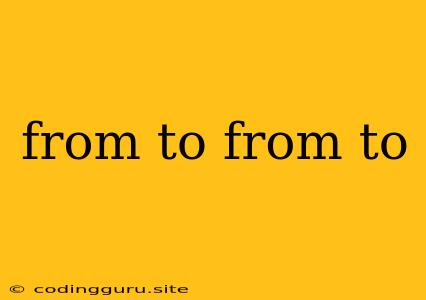Understanding the Importance of "from to" in Programming
"From to" is a fundamental concept in programming, especially when dealing with loops, ranges, and data manipulation. While it might sound simple, it's crucial to grasp its essence to write efficient and effective code. In this article, we'll explore the significance of "from to" and its applications in various programming contexts.
What is "From to" in Programming?
"From to" essentially defines a range, a set of values that start from a specific point and go up to another point. This range can be numbers, characters, or even objects, depending on the language and context.
Imagine you want to print all numbers from 1 to 10. You could use a loop that iterates through each number within that range, from 1 to 10. Here's a simple example in Python:
for i in range(1, 11):
print(i)
This loop iterates through each number from 1 (inclusive) to 11 (exclusive), printing each number in the process. The range is defined by "from 1 to 11".
The Significance of "From to" in Loops
Loops are essential for repetitive tasks in programming. They allow us to execute a block of code multiple times, often with varying values. "From to" comes into play when defining the boundaries of these repetitions. It determines how many times the loop will run and what values will be used in each iteration.
Example:
Let's say you want to calculate the sum of all even numbers between 2 and 20. You could use a loop that iterates from 2 to 20, checking if each number is even and adding it to a running total.
total = 0
for i in range(2, 21, 2): # Step by 2 for even numbers
total += i
print(total)
The "from 2 to 21" defines the range of numbers the loop will iterate through.
Beyond Loops: "From to" in Data Manipulation
"From to" isn't limited to loops. It plays a crucial role in data manipulation and array processing. In many languages, you can access a specific slice of an array using "from to" syntax.
Example (Python):
my_list = [1, 2, 3, 4, 5]
new_list = my_list[1:3] # Take elements from index 1 to 3 (exclusive)
print(new_list) # Output: [2, 3]
The code slices the original list, extracting elements "from index 1 to index 3".
Understanding "From to" in Different Programming Languages
While the concept of "from to" is universal, the specific syntax and behavior might vary across different programming languages. Here's a brief overview:
- Python:
range(start, stop, step)-startis inclusive,stopis exclusive. - JavaScript:
for (let i = start; i < stop; i += step)- Similar to Python,stopis exclusive. - Java:
for (int i = start; i < stop; i += step)-stopis exclusive. - C/C++:
for (int i = start; i < stop; i += step)-stopis exclusive.
Understanding these nuances is crucial for writing accurate code in different languages.
Practical Tips for Using "From to"
- Clarity: Use meaningful variable names to clearly indicate the "from" and "to" values.
- Boundaries: Pay attention to whether the "to" value is inclusive or exclusive.
- Steps: When dealing with ranges, consider using a step value (like 2 for even numbers).
- Iterators: Some languages provide dedicated iterators for specific data types (e.g.,
range()in Python). - Readability: Avoid nested "from to" constructs if possible, as they can become complex.
Error Handling and "From to"
In many situations, errors might arise when using "from to" if the range is defined incorrectly. For instance:
- Infinite Loop: If the "from" value is greater than the "to" value without a step, the loop might run indefinitely.
- Index Out of Bounds: Trying to access an element beyond the array's bounds using "from to" can lead to errors.
Always validate the "from to" values and ensure they are within the expected range to prevent unexpected behavior.
Conclusion
"From to" is a simple yet powerful concept in programming. It allows us to define ranges for loops, manipulate data, and control the flow of execution. By understanding its significance, you can write more efficient, readable, and error-free code. Mastering the art of "from to" is essential for any aspiring programmer.
